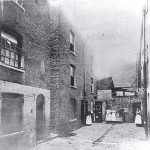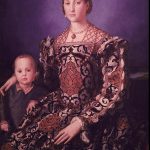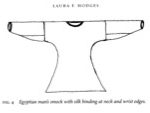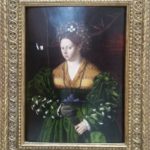
Case Study: Old Nichol Clearance
On April 4th, 1888, a prostitute named Emma Elizabeth Smith was admitted to the London Hospital by the deputy keeper of her common lodging house. The keeper told the house surgeon that Emma was allegedly assaulted by three men, but…

Behind the Scene: The Costs, Collaboration and Commitment of Clothing Construction
This is Eleonora di Toledo, wife of the famous Cosimo I de’ Medici (Grand Duke of Tuscany) and her son Giovanni (Agnolo Bronzino, Eleonora of Toledo with Son Giovanni, c. 1544-5, http://library.artstor.org.prox.miracosta.edu/library/iv2.html?parent=true#). She was a member of one of the…

Smocks in History
A smock is an undergarment that is worn between the skin and the outer garment (s) and, “over the centuries and across geographical and cultural terrain, smock, chemise, or shirt styles maintained basic similarities, while varying from excessively plain to…

Renaissance Portraiture from the Timken
The Portrait of a Lady in a Green Dress painted by Bartolomeo Veneto sometime between 1502-1531 shows the wide, high-waisted voluminous gown complete with contrasting colors and slashed sleeves which expose the blackwork embroidered chemise or smock underneath that are…

Response: London County Council
The Metropolitan Body of Works (MBW) was the primary institution of local governance for the city of London until 1889. After a series of scandals, the MBW lost its jurisdiction and was replaced by the London County Council (LCC). This…

Response: Exogenous Adaptation of Booth’s Work
My past three blog posts have been short biographies of the people involved in the East End census project following the Ripper murders. This week, I hope to take a more in-depth approach to their research and published results. There…
Beads & Crowns: Details Which Further Distinguish Upper Egypt From Lower Egypt
The specific beads that are often found on the beaded apron and beaded hip drape distinguish Upper Egyptian pharaohs from Lower Egyptian pharaohs. Upper Egyptian royalty typically donned the lotus flower while Lower Egyptian royalty sported the papyrus. When both…
Working Bibliography
Calkin, Siobhain Bly. “Marking religion on the body: Saracens, categorization, and The King of Tars.” The Journal of English and Germanic Philology 104.2 (2005): 219+. World History in Context. Web. 3 Oct. 2016. http://prox.miracosta.edu/login?url=http://ic.galegroup.com/ic/whic/AcademicJournalsDetailsPage/AcademicJournalsDetailsWindow?disableHighlighting=false&displayGroupName=Journals&currPage=&scanId=&query=&prodId=WHIC&search_within_results=&p=WHIC%3AUHIC&mode=view&catId=&limiter=&display-query=&displayGroups=&contentModules=&action=e&sortBy=&documentId=GALE%7CA406902224&windowstate=normal&activityType=&failOverType=&commentary=&source=Bookmark&u=ocea63505&jsid=7f790684dd5c2cc4fec0c80472e6613a This article is a dissection of…
Christianity, Islam and Judaism
Clothing was used as not only a way to display ones’ membership to a certain group but it was also a way for Muslims and Jews to differentiate themselves from Christians. The idea of integration and miscegenation was such a…
Costuming and kinship
Societies that are dominated by the importance of kinship, costume becomes one way to express and display that membership. Societies have long used costume to distinguish themselves from other tribes and the Ancient Egyptians are no exception. Each piece of…
Recent Comments